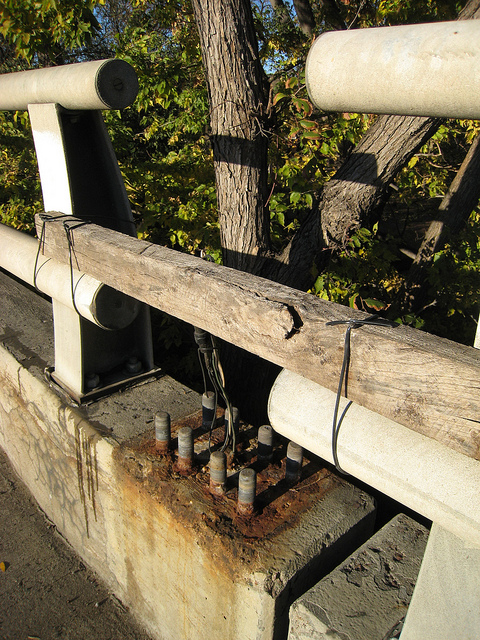Michigan is looking to lead the nation in developing smart road technology that will allow intersection signals and construction zones to alert next generation vehicles about upcoming red lights, lane closures, and traffic areas ahead. According to The Detroit News, General Motors and Macomb County, Michigan have partnered up to begin testing smart road safety features that can tell future cars to begin braking when traffic lights are about to turn red. Michigan has also begun testing 'connected construction zones' on Interstate 75 in Oakland County that can alert cars with 'vehicle-infrastructure-capability' about upcoming lane closures. Vehicle-infrastructure-capability allows vehicles to communicate with roadways, construction zones and traffic signals through smart technology.
These 'connected construction zones' operate by advanced-tech roadside bar codes that are able to communicate information from construction zones to oncoming vehicles. These smart traffic signal systems can even tell the difference between construction workers from traffic barrels for the safety of both the worker and driver as well. Reportedly, these roadside bar codes are intended to be the system that will navigate autonomous vehicles in the future. Michigan has already established 100 miles of connected roadways and plans to expand to 350 miles in the future. Automakers and auto suppliers alike in Southeast Michigan have already begun planning for this transition by testing autonomous vehicle technology on Michigan roadways.
Citizens of Michigan who are interested in knowing what these road signals look like, should look out for bar codes signs with black and white 2D codes that have been implemented on I-75 in Oakland County. These signs appear to be QR codes that can be scanned by smartphones, however, they can only be read by test cars with vehicle-infrastructure intuition. 3M Company provided these signs for Michigan, and Tammy Meehan, global portfolio manager for 3M Connected Roads, explains that these signs contain pinpoint GPS navigation, can alert vehicles of upcoming construction zones, and can estimate the time it takes to drive through work zones. These smart traffic signal systems can even tell the difference between construction workers from traffic barrels for the safety of both the worker and driver as well.
Outside the GM Tech Center in Warren, advanced technology has been implemented into traffic lights by Macomb County on Mound Road between 12 Mile Road and 13 Mile Road. These lights are able communicate with Cadillac CTS test sedans that possess vehicle-infrastructure capability. The Detroit News reports that the smart traffic signals and sensors calculate the driver’s speed and the time in which the traffic signal will turn red, to determine if the driver needs to begin braking. In such a case, a yellow light glows on the driver’s infotainment screen and their seat begins vibrating. This is intended to prevent the driver from running the red light or crashing into another vehicle. The smart traffic signals work within a 1,000-foot radius.
Mark Hackel, Macomb County Executive, stated that for the past five years Macomb's infrastructure department has been installing advanced sensors and cameras to develop smart highways. Hackel explains that the partnership with GM, in addition to the $13.5 million-dollar creation of the Communications and Technology Center (COMTEC) that opened in Mount Clemens in 2013, have been a part of the County’s ongoing infrastructure investments. COMTEC has allowed for the development of Michigan traffic-monitoring, weather-mapping, road-department cameras, and a video wall with 40 monitors.
Kirk Steudle, Director of the Michigan Department of Transportation, stated that Michigan continues to partner with automakers and suppliers for the research and development of autonomous vehicles and smart technology. Kirk claims that advanced vehicle-infrastructure communication could reduce 80% of car accident fatalities.
While Michigan making great headway, it is not alone in its efforts to develop smart roadways. Other states, including Ohio, have begun testing and implementing connected roadways as well. Ohio has decided to invest $15 million into developing the U.S. 33 Smart Mobility Corridor using advanced fiber-optic cables and wireless sensors for connected roadway and autonomous vehicle testing. Ohio plans to expand connected roadways to I-270 and I-90 as well.
The smart technology innovation that Michiganders are experiencing before them will transform the way we mobilize, by making transportation far more efficient and safer. The ability for autonomous vehicles and connected highways to communicate may greatly reduce car accident fatalities in the future. Yet, it will still be some time before Michigan citizens are able to experience this transformation. In the meanwhile, The Michigan Law Firm, PLLC will continue to update blog readers on the development of smart roadway technology and its effects on drivers in Michigan and across the country.
Whether you've been involved in an auto accident with with a driverless car or were struck by a negligent driver, call The Michigan Law Firm, PLLC at 844.4MI.FIRM. for a free consultation. Our firm assists victims of car accidents in recouping any benefits they may be entitled to under Michigan law.






